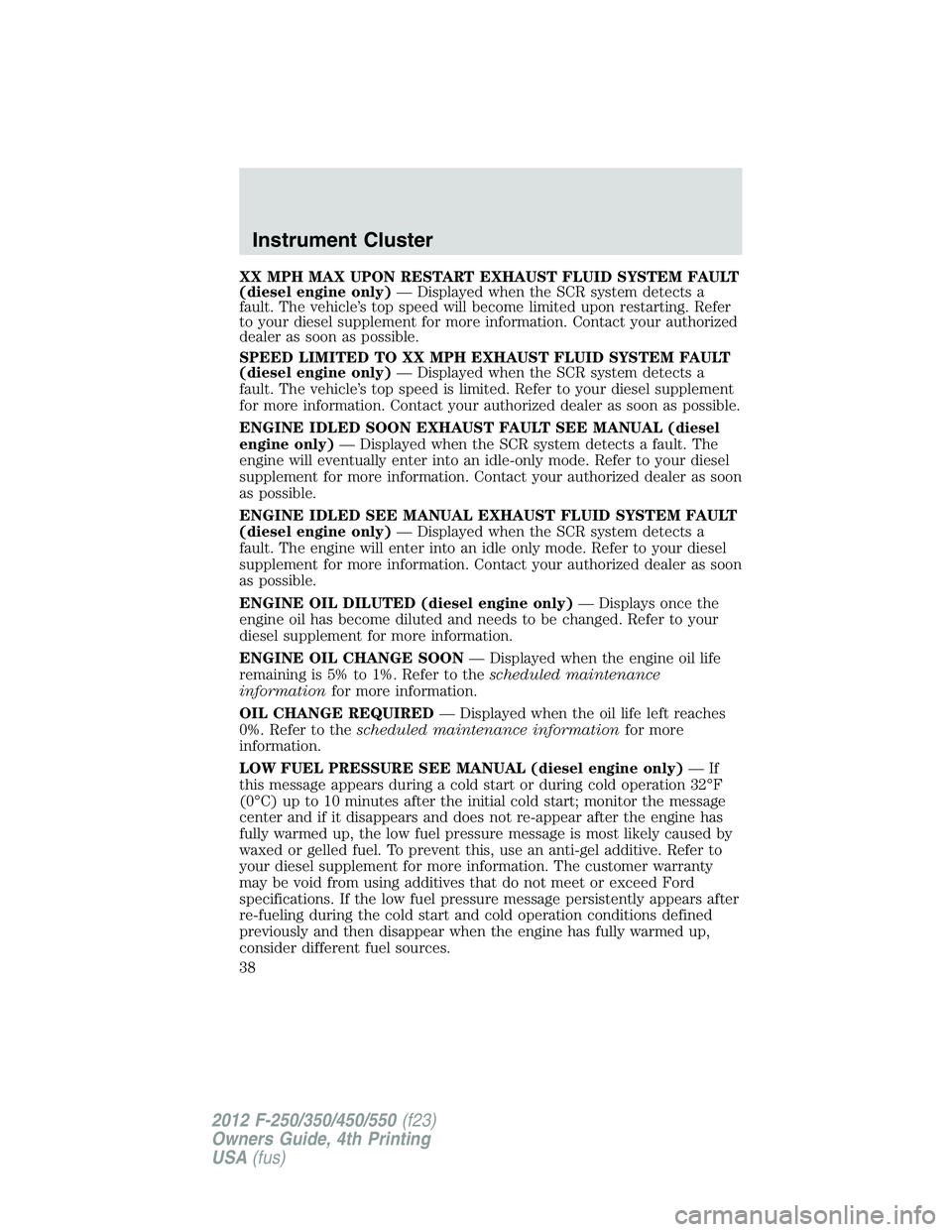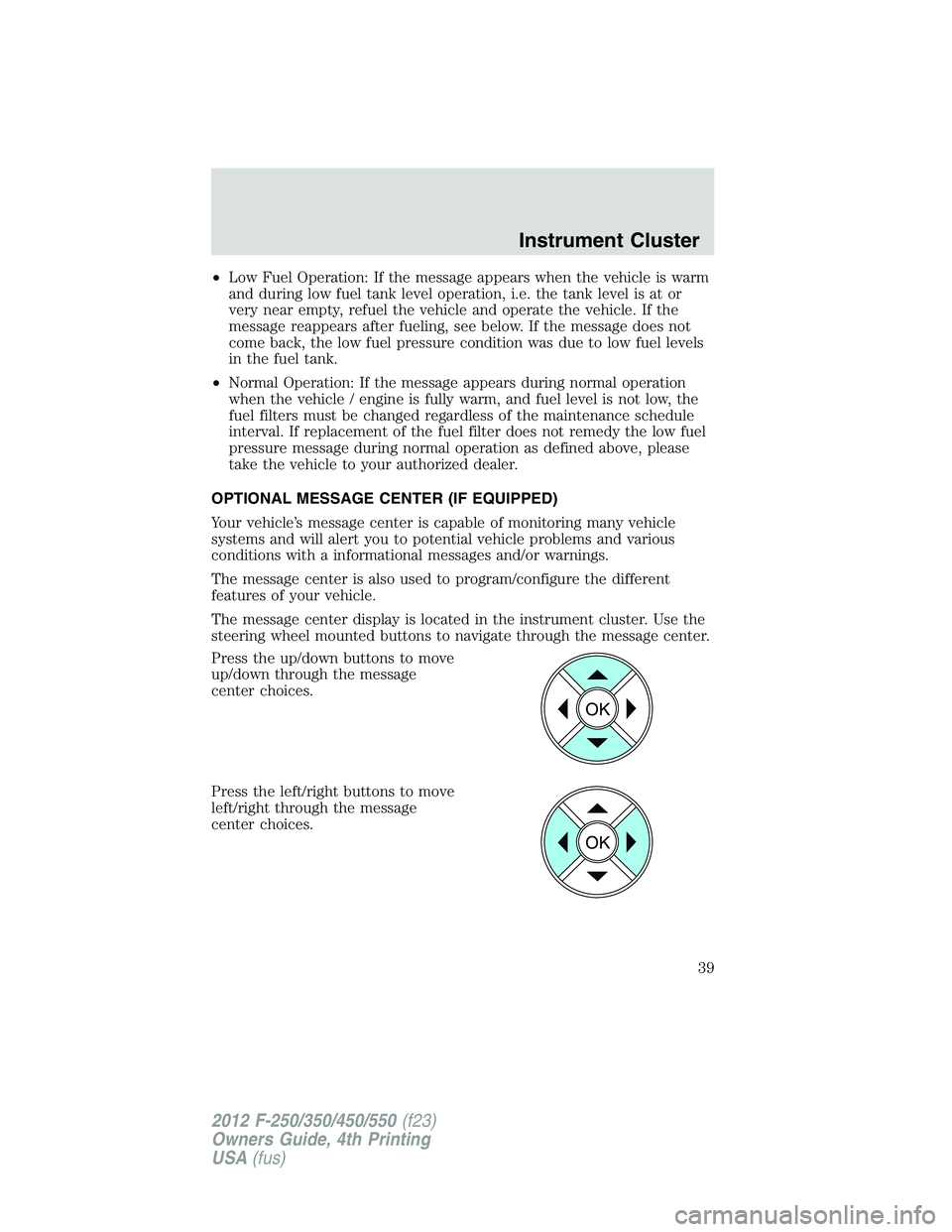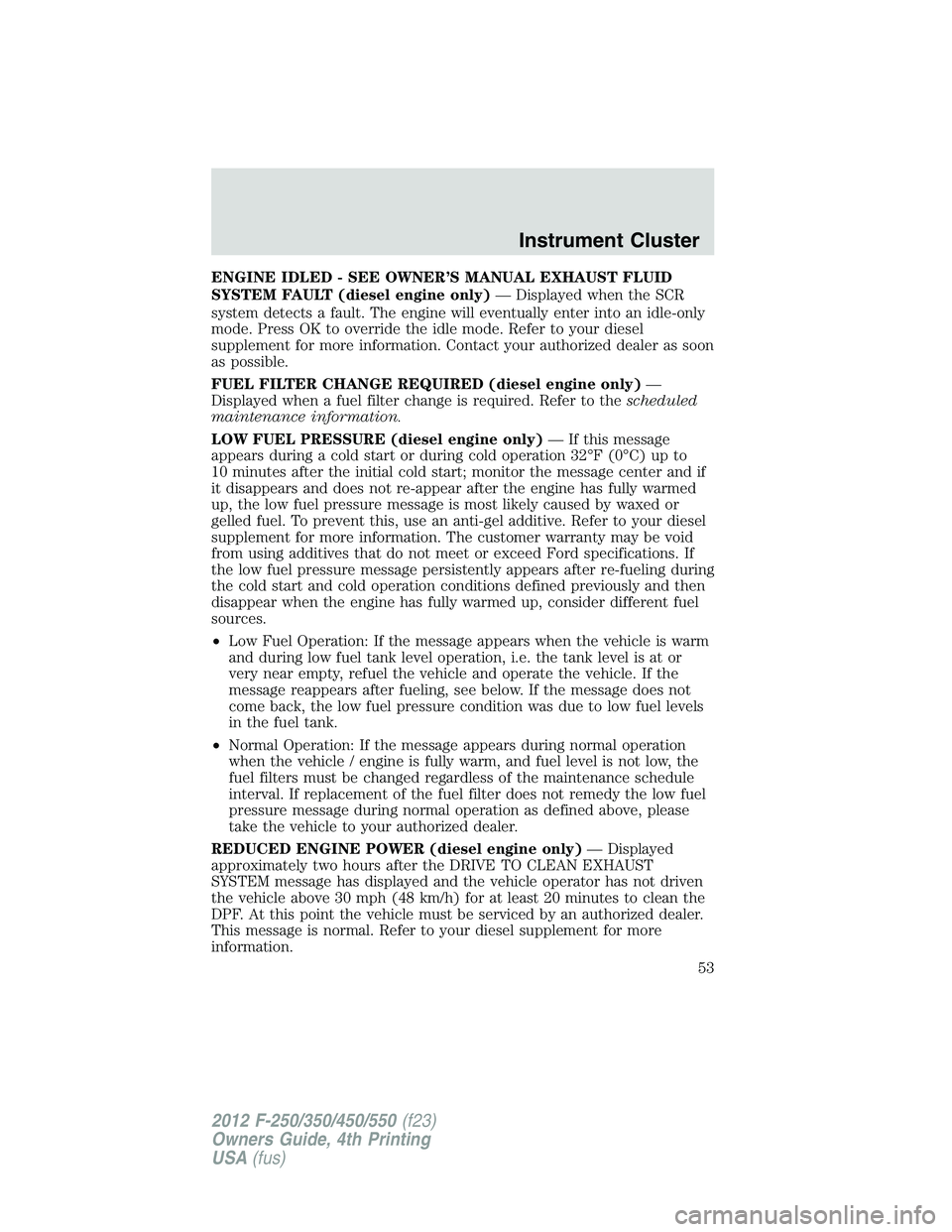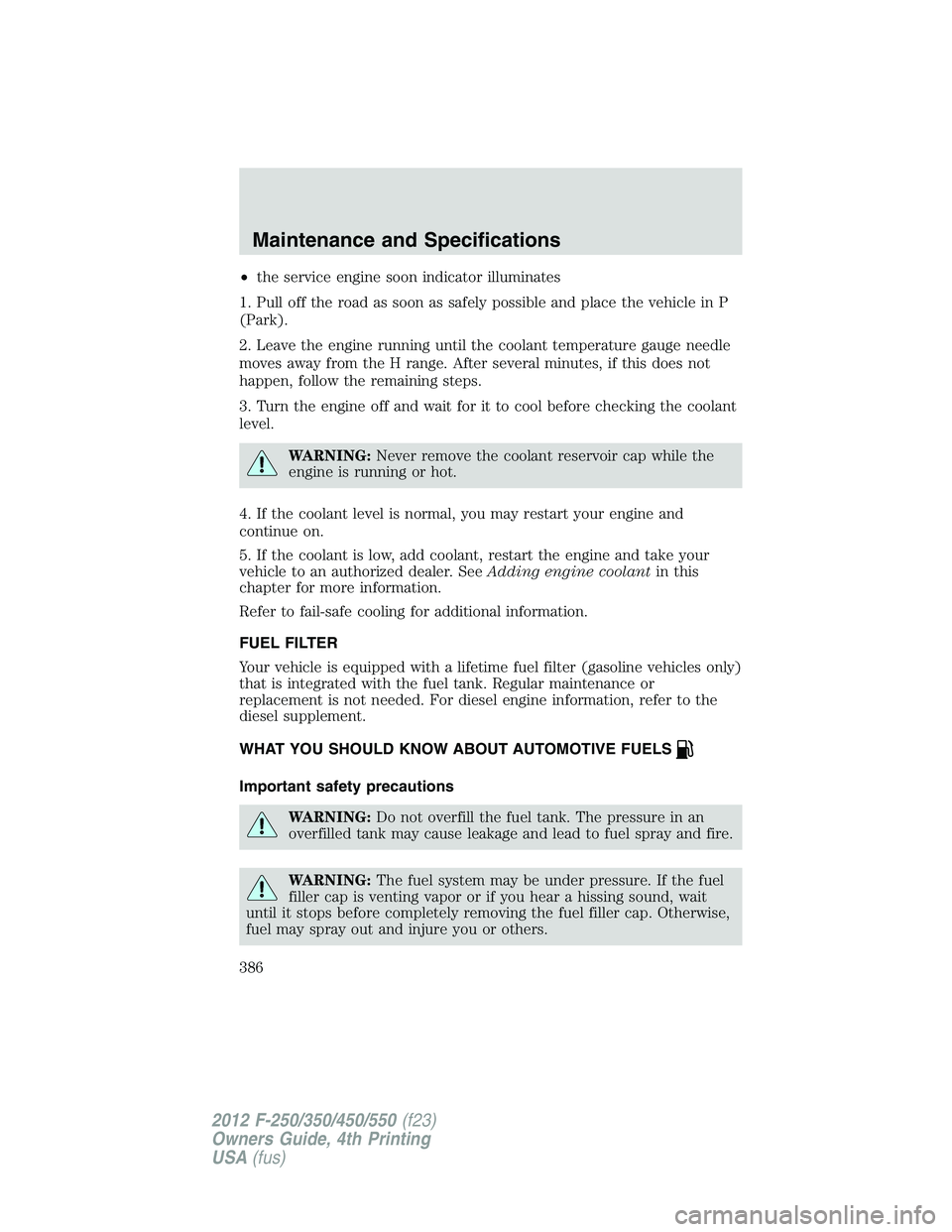2012 FORD F250 SUPER DUTY fuel pressure
[x] Cancel search: fuel pressurePage 13 of 448

Vehicle Symbol Glossary
Power Windows
Front/Rear Power Window Lockout
Child Safety Door
Lock/Unlock Interior Luggage
Compartment Release
Panic Alarm Engine Oil
Engine Coolant Engine Coolant
Temperature
Do Not Open When Hot Battery
Avoid Smoking, Flames,
or Sparks Battery Acid
Explosive Gas Fan Warning
Power Steering Fluid Maintain Correct Fluid
Level MAX
MIN
Service Engine Soon Engine Air Filter
Passenger Compartment
Air Filter Jack
Check Fuel Cap Low Tire Pressure
WarningIntroduction
13
2012 F-250/350/450/550 (f23)
Owners Guide, 4th Printing
USA (fus)
Page 30 of 448

PARK BRAKE ENGAGED — Displayed when the parking brake is set,
the engine is running and the vehicle is driven more than 3 mph
(5 km/h). If the warning stays on after the parking brake is released,
contact your authorized dealer as soon as possible.
CHECK BRAKE SYSTEM — Displayed when a fault has been detected
by the ABS module.
BRAKE FLUID LEVEL LOW — Indicates the brake fluid level is low
and the brake system should be inspected immediately. Refer to Brake
fluid in the Maintenance and Specifications chapter.
FUEL LEVEL LOW — Displayed as a reminder of a low fuel condition.
CHECK PARK AID (if equipped) — Displayed when the transmission
is in R (Reverse) and the reverse sensing system (park aid) is disabled.
Refer to Rear park aid in this section to enable.
TIRE PRESSURE SENSOR FAULT (if equipped) — Displayed when
a tire pressure sensor is malfunctioning, or your spare tire is in use. For
more information on how the system operates under these conditions,
refer to Understanding Your Tire Pressure Monitoring System
(TPMS) in the Tires, Wheels and Loading chapter. If the warning stays
on or continues to come on, contact your authorized dealer as soon as
possible.
LOW TIRE PRESSURE (if equipped) — Displayed when one or more
tires on your vehicle have low tire pressure. Refer to Inflating your
tires in the Tires, Wheels and Loading chapter.
TIRE PRESSURE MONITOR FAULT (if equipped) — Displayed
when the tire pressure monitoring system (TPMS) is functioning. If the
warning stays on or continues to come on, contact your authorized
dealer as soon as possible.
TRAIN LEFT FRONT TIRE (if equipped) — Displayed when training
the TPMS. Refer to TPMS reset procedure in the Tires, Wheels and
Loading chapter for more information.
TRAIN RIGHT FRONT TIRE (if equipped) — Displayed when
training the TPMS. Refer to TPMS reset procedure in the Tires, Wheels
and Loading chapter for more information.
TRAIN RIGHT REAR TIRE (if equipped) — Displayed when training
the TPMS. Refer to TPMS reset procedure in the Tires, Wheels and
Loading chapter for more information.
TRAIN LEFT REAR TIRE (if equipped) — Displayed when training
the TPMS. Refer to TPMS reset procedure in the Tires, Wheels and
Loading chapter for more information.Instrument Cluster
30
2012 F-250/350/450/550 (f23)
Owners Guide, 4th Printing
USA (fus)
Page 38 of 448

XX MPH MAX UPON RESTART EXHAUST FLUID SYSTEM FAULT
(diesel engine only) — Displayed when the SCR system detects a
fault. The vehicle’s top speed will become limited upon restarting. Refer
to your diesel supplement for more information. Contact your authorized
dealer as soon as possible.
SPEED LIMITED TO XX MPH EXHAUST FLUID SYSTEM FAULT
(diesel engine only) — Displayed when the SCR system detects a
fault. The vehicle’s top speed is limited. Refer to your diesel supplement
for more information. Contact your authorized dealer as soon as possible.
ENGINE IDLED SOON EXHAUST FAULT SEE MANUAL (diesel
engine only) — Displayed when the SCR system detects a fault. The
engine will eventually enter into an idle-only mode. Refer to your diesel
supplement for more information. Contact your authorized dealer as soon
as possible.
ENGINE IDLED SEE MANUAL EXHAUST FLUID SYSTEM FAULT
(diesel engine only) — Displayed when the SCR system detects a
fault. The engine will enter into an idle only mode. Refer to your diesel
supplement for more information. Contact your authorized dealer as soon
as possible.
ENGINE OIL DILUTED (diesel engine only) — Displays once the
engine oil has become diluted and needs to be changed. Refer to your
diesel supplement for more information.
ENGINE OIL CHANGE SOON — Displayed when the engine oil life
remaining is 5% to 1%. Refer to the scheduled maintenance
information for more information.
OIL CHANGE REQUIRED — Displayed when the oil life left reaches
0%. Refer to the scheduled maintenance information for more
information.
LOW FUEL PRESSURE SEE MANUAL (diesel engine only) —If
this message appears during a cold start or during cold operation 32°F
(0°C) up to 10 minutes after the initial cold start; monitor the message
center and if it disappears and does not re-appear after the engine has
fully warmed up, the low fuel pressure message is most likely caused by
waxed or gelled fuel. To prevent this, use an anti-gel additive. Refer to
your diesel supplement for more information. The customer warranty
may be void from using additives that do not meet or exceed Ford
specifications. If the low fuel pressure message persistently appears after
re-fueling during the cold start and cold operation conditions defined
previously and then disappear when the engine has fully warmed up,
consider different fuel sources.Instrument Cluster
38
2012 F-250/350/450/550 (f23)
Owners Guide, 4th Printing
USA (fus)
Page 39 of 448

• Low Fuel Operation: If the message appears when the vehicle is warm
and during low fuel tank level operation, i.e. the tank level is at or
very near empty, refuel the vehicle and operate the vehicle. If the
message reappears after fueling, see below. If the message does not
come back, the low fuel pressure condition was due to low fuel levels
in the fuel tank.
• Normal Operation: If the message appears during normal operation
when the vehicle / engine is fully warm, and fuel level is not low, the
fuel filters must be changed regardless of the maintenance schedule
interval. If replacement of the fuel filter does not remedy the low fuel
pressure message during normal operation as defined above, please
take the vehicle to your authorized dealer.
OPTIONAL MESSAGE CENTER (IF EQUIPPED)
Your vehicle’s message center is capable of monitoring many vehicle
systems and will alert you to potential vehicle problems and various
conditions with a informational messages and/or warnings.
The message center is also used to program/configure the different
features of your vehicle.
The message center display is located in the instrument cluster. Use the
steering wheel mounted buttons to navigate through the message center.
Press the up/down buttons to move
up/down through the message
center choices.
Press the left/right buttons to move
left/right through the message
center choices. OK
OKInstrument Cluster
39
2012 F-250/350/450/550 (f23)
Owners Guide, 4th Printing
USA (fus)
Page 53 of 448

ENGINE IDLED - SEE OWNER’S MANUAL EXHAUST FLUID
SYSTEM FAULT (diesel engine only) — Displayed when the SCR
system detects a fault. The engine will eventually enter into an idle-only
mode. Press OK to override the idle mode. Refer to your diesel
supplement for more information. Contact your authorized dealer as soon
as possible.
FUEL FILTER CHANGE REQUIRED (diesel engine only) —
Displayed when a fuel filter change is required. Refer to the scheduled
maintenance information.
LOW FUEL PRESSURE (diesel engine only) — If this message
appears during a cold start or during cold operation 32°F (0°C) up to
10 minutes after the initial cold start; monitor the message center and if
it disappears and does not re-appear after the engine has fully warmed
up, the low fuel pressure message is most likely caused by waxed or
gelled fuel. To prevent this, use an anti-gel additive. Refer to your diesel
supplement for more information. The customer warranty may be void
from using additives that do not meet or exceed Ford specifications. If
the low fuel pressure message persistently appears after re-fueling during
the cold start and cold operation conditions defined previously and then
disappear when the engine has fully warmed up, consider different fuel
sources.
• Low Fuel Operation: If the message appears when the vehicle is warm
and during low fuel tank level operation, i.e. the tank level is at or
very near empty, refuel the vehicle and operate the vehicle. If the
message reappears after fueling, see below. If the message does not
come back, the low fuel pressure condition was due to low fuel levels
in the fuel tank.
• Normal Operation: If the message appears during normal operation
when the vehicle / engine is fully warm, and fuel level is not low, the
fuel filters must be changed regardless of the maintenance schedule
interval. If replacement of the fuel filter does not remedy the low fuel
pressure message during normal operation as defined above, please
take the vehicle to your authorized dealer.
REDUCED ENGINE POWER (diesel engine only) — Displayed
approximately two hours after the DRIVE TO CLEAN EXHAUST
SYSTEM message has displayed and the vehicle operator has not driven
the vehicle above 30 mph (48 km/h) for at least 20 minutes to clean the
DPF. At this point the vehicle must be serviced by an authorized dealer.
This message is normal. Refer to your diesel supplement for more
information. Instrument Cluster
53
2012 F-250/350/450/550 (f23)
Owners Guide, 4th Printing
USA (fus)
Page 54 of 448

WATER IN FUEL DRAIN FILTER SEE MANUAL (if equipped) —
Displayed when the water separator has reached a predetermined
capacity and needs to be drained. Refer to your diesel supplement for
more information.
LOW TIRE PRESSURE — Displayed when one or more tires on your
vehicle have low tire pressure. Refer to Inflating Your Tires in the
Tires, Wheels and Loading chapter.
TIRE PRESSURE MONITOR FAULT — Displayed when the Tire
Pressure Monitoring System is malfunctioning. If the warning stays on or
continues to come on, have the system inspected by your authorized
dealer.
TIRE PRESSURE SENSOR FAULT — Displayed when a tire pressure
sensor is malfunctioning, or your spare tire is in use. For more
information on how the system operates under these conditions, refer to
Understanding Your Tire Pressure Monitoring System (TPMS) in the
Tires, Wheels and Loading chapter. If the warning stays on or
continues to come on, contact your authorized dealer as soon as
possible.
TIRES NOT TRAINED - REPEAT — Displayed when an error occurs
while training the TPMS. Refer to TPMS reset procedure in the Tires,
Wheels and Loading chapter for more information.
TRAIN INNER LEFT REAR TIRE — Displayed when training the
TPMS. Refer to TPMS reset procedure in the Tires, Wheels and
Loading chapter for more information.
TRAIN INNER RIGHT REAR TIRE — Displayed when training the
TPMS. Refer to TPMS reset procedure in the Tires, Wheels and
Loading chapter for more information.
TRAIN LEFT FRONT TIRE — Displayed when training the TPMS
system. Refer to TPMS reset procedure in the Tires, Wheels and
Loading chapter for more information.
TRAIN LEFT REAR TIRE — Displayed when training the TPMS
system. Refer to TPMS reset procedure in the Tires, Wheels and
Loading chapter for more information.
TRAIN RIGHT FRONT TIRE — Displayed when training the TPMS
system. Refer to TPMS reset procedure in the Tires, Wheels and
Loading chapter for more information.
TRAIN RIGHT REAR TIRE — Displayed when training the TPMS
system. Refer to TPMS reset procedure in the Tires, Wheels and
Loading chapter for more information.Instrument Cluster
54
2012 F-250/350/450/550 (f23)
Owners Guide, 4th Printing
USA (fus)
Page 237 of 448

TIRE PRESSURE MONITORING SYSTEM (TPMS) (IF EQUIPPED)
WARNING: The tire pressure monitoring system is NOT a
substitute for manually checking tire pressure. The tire pressure
should be checked periodically (at least monthly) using a tire gauge,
see Inflating your tires in this chapter. Failure to properly maintain
your tire pressure could increase the risk of tire failure, loss of control,
vehicle rollover and personal injury.
Each tire, including the spare (if
provided), should be checked
monthly when cold and inflated to
the inflation pressure recommended
by the vehicle manufacturer on the
vehicle placard or tire inflation pressure label. (If your vehicle has tires
of a different size than the size indicated on the vehicle placard or tire
inflation pressure label, you should determine the proper tire inflation
pressure for those tires.)
As an added safety feature, your vehicle has been equipped with a tire
pressure monitoring system (TPMS) that illuminates a low tire pressure
telltale when one or more of your tires is significantly under-inflated.
Accordingly, when the low tire pressure telltale illuminates, you should
stop and check your tires as soon as possible, and inflate them to the
proper pressure. Driving on a significantly under-inflated tire causes the
tire to overheat and can lead to tire failure. Under-inflation also reduces
fuel efficiency and tire tread life, and may affect the vehicle’s handling
and stopping ability.
Please note that the TPMS is not a substitute for proper tire
maintenance, and it is the driver’s responsibility to maintain correct tire
pressure, even if under-inflation has not reached the level to trigger
illumination of the TPMS low tire pressure telltale.
Your vehicle has also been equipped with a TPMS malfunction indicator
to indicate when the system is not operating properly. The TPMS
malfunction indicator is combined with the low tire pressure telltale.
When the system detects a malfunction, the telltale will flash for
approximately one minute and then remain continuously illuminated.
This sequence will continue upon subsequent vehicle start-ups as long as
the malfunction exists.
When the malfunction indicator is illuminated, the system may not be
able to detect or signal low tire pressure as intended. TPMS malfunctions
may occur for a variety of reasons, including the installation of Tires, Wheels and Loading
237
2012 F-250/350/450/550 (f23)
Owners Guide, 4th Printing
USA (fus)
Page 386 of 448

• the service engine soon indicator illuminates
1. Pull off the road as soon as safely possible and place the vehicle in P
(Park).
2. Leave the engine running until the coolant temperature gauge needle
moves away from the H range. After several minutes, if this does not
happen, follow the remaining steps.
3. Turn the engine off and wait for it to cool before checking the coolant
level.
WARNING: Never remove the coolant reservoir cap while the
engine is running or hot.
4. If the coolant level is normal, you may restart your engine and
continue on.
5. If the coolant is low, add coolant, restart the engine and take your
vehicle to an authorized dealer. See Adding engine coolant in this
chapter for more information.
Refer to fail-safe cooling for additional information.
FUEL FILTER
Your vehicle is equipped with a lifetime fuel filter (gasoline vehicles only)
that is integrated with the fuel tank. Regular maintenance or
replacement is not needed. For diesel engine information, refer to the
diesel supplement.
WHAT YOU SHOULD KNOW ABOUT AUTOMOTIVE FUELS
Important safety precautions
WARNING: Do not overfill the fuel tank. The pressure in an
overfilled tank may cause leakage and lead to fuel spray and fire.
WARNING: The fuel system may be under pressure. If the fuel
filler cap is venting vapor or if you hear a hissing sound, wait
until it stops before completely removing the fuel filler cap. Otherwise,
fuel may spray out and injure you or others.Maintenance and Specifications
386
2012 F-250/350/450/550 (f23)
Owners Guide, 4th Printing
USA (fus)